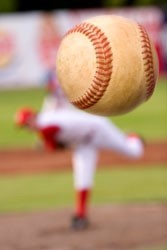
Part 1: Vision Strategies for Baseball/Softball Batters
By Ken Cherryhomes ©2024
In the early to mid-2000’s, I was training the son of Seattle Mariners vision specialist, Dr. Doug Nikaitani. In exchange for batting lessons for his son, Dr. Nikaitani trained me on vision strategies and a condensed education on vision. One of the techniques he taught me, and that I recommend is peripheral gaze strategy, a form of soft focus or “open focus,” which is sometimes also referred to as global visual attention.
In a batting context, soft focus would mean not fixating on the pitcher or the ball but rather widening your gaze to take in the entire field of play. This allows you to be aware of the pitcher’s movements, the ball’s trajectory, and even the fielders’ positions, all without shifting your gaze.
Advantages:
- Enhanced Situational Awareness: By not fixating on a single point, you can better perceive movements of the pitch and changes in the broader field, allowing for better decision-making.
- Reduced Tunnel Vision: Soft focus can help prevent the tunnel vision that sometimes occurs under pressure, ensuring that you don’t miss important peripheral cues.
- Improved Reaction Time: Some athletes find that a soft focus allows them to react more naturally and fluidly, as it engages more instinctual rather than analytical processes.
Employing a soft focus or peripheral gaze strategy will reduce or even eliminate saccadic eye movements during batting. Saccades are rapid eye movements that occur when we shift our gaze from one point to another. In a hard focus strategy like “quiet eye,” the eyes would make saccades to fixate on specific points, such as the pitcher’s release point or the ball’s trajectory, or a shift of attention from one to the other.
Implications:
- Reduced Information Lag: Saccades introduce a slight information lag because visual processing is suppressed during these rapid eye movements. By reducing saccades, a batter may gain a few milliseconds for decision-making and reaction, which can be crucial in a sport where pitches can exceed 90 mph. This lag or “blind spots” are inherently compensated for by perceptual filling-in, a seamless representation of visual perception. Perceptual filling-in is a phenomenon where the brain fills in missing information in our visual perception.
- Continuous Monitoring: A soft focus would allow for continuous monitoring of the entire field, including the pitcher’s movements and the ball’s trajectory, without the need for rapid gaze shifts.
- Enhanced Fluidity: The absence of saccades might contribute to smoother, more fluid motor responses. This could be particularly beneficial when adjusting to off-speed pitches or making last-millisecond decisions to swing or not.
The adoption of a peripheral gaze strategy, or soft focus, in baseball and softball batting can offer significant advantages to players. By widening one’s gaze to encompass the entire field of play, athletes can enhance their situational awareness, reduce tunnel vision under pressure, and potentially improve reaction time.
This technique minimizes or eliminates saccadic eye movements, which can introduce information lag during crucial moments in the game. In contrast, a soft focus allows for continuous monitoring of the field and may contribute to smoother, more fluid motor responses.
Ultimately, the peripheral gaze strategy represents a valuable tool for batters seeking to optimize their performance, enabling them to make better-informed decisions and react swiftly to the dynamic nature of the game, especially when facing fast pitches or unexpected changes in play.